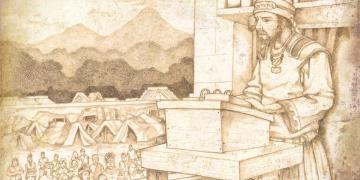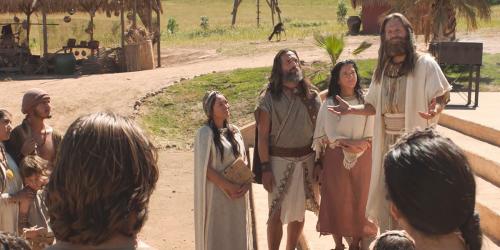You are here
Book of Mormon Central is in the process of migrating to our new Scripture Central website.
We ask for your patience during this transition. Over the coming weeks, all pages of bookofmormoncentral.org will be redirected to their corresponding page on scripturecentral.org, resulting in minimal disruption.

Scripture Block
2 Nephi 6-10
February 10-16. “O How Great the Plan of Our God!”
KnoWhys
Recommended Resources
Learn about the Book of Mormon with verse by verse commentaries from renowned Book of Mormon scholars like John W. Welch and Brant A. Gardner in the ScripturePlus app. Read this week's KnoWhy connected with the Come Follow Me curriculum, and watch a video elucidating an insight in this week's scripture reading.
Reading Plan
Structure your personal scripture study by following a multimedia, day by day plan. Each day's assignment includes the required scripture passages from the Come Follow Me curriculum, as well as suggestions for additional resources to bring context and understanding to your study.
Monday
- 2 Nephi 6:1–18
- KnoWhy 32: Did Jacob Refer to Ancient Israelite Autumn Festivals?
- KnoWhy 277: Why Does Jacob Describe God as a Divine Warrior?
Tuesday
- 2 Nephi 7:1–3
- Quote: “However late you think you are, however many chances you think you have missed, however many mistakes you feel you have made or talents you think you don’t have, or however far from home and family and God you feel you have traveled, I testify that you have not traveled beyond the reach of divine love. It is not possible for you to sink lower than the infinite light of Christ’s Atonement shines.” Holland, Jeffery R. "The Laborers in the Vineyard." General Conference April 2012.
- 2 Nephi 7:4–11
- Quote: “Two classes of people are contrasted in these two verses. One class consists of those who fear the Lord and obey his servant. They will not walk in spiritual darkness but will have spiritual light . . . The other class consists of those who seek to be spiritually self-sufficient, relying on themselves instead of on God. They attempt to create their own light but their efforts produce no more than sparks . . . when compared to the bright light that comes from God. Those in this group will eventually receive judgments from the Lord, resulting in sorrow.” Parry, Donald W., Jay A. Parry, and Tina M. Peterson. Understanding Isaiah. Salt Lake City, UT: Deseret Book, 1998.
Wednesday
- 2 Nephi 8:1–10
- Quote: "Abraham is the rock, and Sarah is the quarry. We must live up to the covenant called after Abraham. Ultimately, the covenant is centered on the Rock of our Salvation, which is Jesus Christ. Just as a rock will have the same physical properties and composition as the mountain from which it is taken, so we have the potential to become like our Father and his Son, our only sure foundation." Ogden, D. Kelly, and Andrew C. Skinner. Verse by Verse: The Book of Mormon. Salt Lake City, UT: Deseret Book, 2011.
- Quote: "The 'dragon' is easily identified as Satan. The identity of 'Rahab' is a little more difficult. Some scholars suggest Rahab represents Egypt while others say it is a sea monster representing Satan. Footnote reference 'c' in [2 Nephi 8:9] cites Isaiah 27:1 as a cross-reference, which speaks of 'leviathan that crooked serpent.' The footnote identifies 'leviathan' as 'a legendary sea-monster representing the forces of chaos that opposed the Creator.'" Brewster, Hoyt W. Isaiah Plain & Simple: The Message of Isaiah in the Book of Mormon. Salt Lake City, UT: Deseret Book, 1995.
- 2 Nephi 8:11–25
-
Quote: "Their ministry will take place after the latter-day temple has been built in Old Jerusalem, after some of the Jews who dwell there have been converted, and just before Armageddon and the return of the Lord Jesus. How long will they minister in Jerusalem and in the Holy Land? For three and a half years, the precise time spent by the Lord in his ministry to the ancient Jews. The Jews, as an assembled people, will hear again the testimony of legal administrators bearing record that salvation is in Christ and in his gospel. Who will these witnesses be? We do not know, except that they will be followers of Joseph Smith; they will hold the holy Melchizedek Priesthood; they will be members of The Church of Jesus Christ of Latter-day Saints. It is reasonable to suppose, knowing how the Lord has always dealt with his people in all ages, that they will be two members of the Council of the Twelve or of the First Presidency of the Church.
How will their witness be received by the people? This we do know. It will be with these two witnesses as it was with their Lord some two millenniums before. The righteous will believe their words, and the wicked will thirst for their blood. 'And if any man will hurt them, fire proceedeth out of their mouth, and devoureth their enemies: and if any man will hurt them, he must in this manner be killed. These have power to shut heaven, that it rain not in the days of their prophecy: and have power over waters to turn them to blood, and to smite the earth with all plagues, as often as they will.' It will be with them as it was with Elijah, who both called down fire from heaven to consume his enemies and sealed the heavens that there was neither dew nor rain for three and a half years. And it will be with them as it was with Moses, who turned the rivers and waters of Egypt into blood and who smote the Egyptians with many plagues." McConkie, Bruce R. The Millennial Messiah: The Second Coming of the Son of Man. Salt Lake City, UT: Deseret Book, 1982.
Thursday
- 2 Nephi 9:1–9
- Quote: “Verses 1-3 constitute a doctrinal bridge to verse 4 and the verses following. Jacob moved from talking about the scattering and gathering of Israel to a discussion of physical death, and then to resurrection, because they are parallel. Death is the scattering of elements, and resurrection is the gathering or restoration of those elements. To Jacob and other Book of Mormon prophets, the doctrines of the gospel or plan of salvation are all interconnected – one seamless web.” Ogden, D. Kelly, and Andrew C. Skinner. Verse by Verse: the Book of Mormon. Salt Lake City, UT: Deseret Book, 2011.
- Quote: “The phrase ‘infinite atonement’ or ‘infinite sacrifice’ may refer to an atonement or sacrifice by a God, a being who is infinite in knowledge, power, and glory. Amulek makes that connection when he observes that the ‘great and last sacrifice will be the Son of God, yea, infinite and eternal.’ Accordingly, the Atonement is ‘infinite’ because its source is ‘infinite.’ But the Atonement is infinite in other ways as well.” Callister, Tad R. The Infinite Atonement. Salt Lake City, UT: Deseret Book, 2000.
- KnoWhy 33: When Does the Book of Mormon First Talk About the Plan of Salvation?
- Video 754: What Does the Book of Mormon Teach Us about the Resurrection? (2:50)
Friday
- 2 Nephi 9:10–15
- Quote: “The most important doctrine I can declare, and the most powerful testimony I can bear, is of the atoning sacrifice of the Lord Jesus Christ. His atonement is the most transcendent event that ever has or ever will occur from Creation’s dawn through all the ages of a never-ending eternity. It is the supreme act of goodness and grace that only a god could perform. Through it, all of the terms and conditions of the Father’s eternal plan of salvation became operative. Through it are brought to pass the immortality and eternal life of man.” McConkie, Bruce R. “The Purifying Power of Gethsemane.” General Conference May 1985.
- KnoWhy 34: Why Does Jacob Choose a “Monster” as a Symbol for Death and Hell?
- 2 Nephi 16–26
- KnoWhy 446: Why Does the Book of Mormon Warn that a Lake of Fire and Brimstone Awaits Sinners in the Afterlife?
Saturday
- 2 Nephi 9:27–54
- KnoWhy 487: What Role Should Scholarship Play in Studying the Book of Mormon?
- 2 Nephi 30–54
- KnoWhy 35: Why Does Jacob Declare so Many “Woes”?
Sunday
- 2 Nephi 10:1–25
- KnoWhy 36: Why Does an Angel Reveal the Name of Christ to Jacob?
Additional Resources
Poetry Selections
Anderson, Sharon. "Seventh Child (2 Nephi 8:2)." The Glory of the Son—Poetic Insights: Jesus Christ and God’s Great Plan of Happiness.
Anderson, Sharon. "Robes of Righteousness (2 Nephi 9:14)." The Glory of the Son—Poetic Insights: Jesus Christ and God’s Great Plan of Happiness.
Anderson, Sharon. "Holiness to the Lord (2 Nephi 9:49)." The Glory of the Son—Poetic Insights: Jesus Christ and God’s Great Plan of Happiness.
2 Nephi 6
Belnap, Daniel. "“I Will Contend with Them That Contendeth with Thee”: The Divine Warrior in Jacob’s Speech of 2 Nephi 6–10." Journal of the Book of Mormon and Restoration Scripture 17, no. 1-2 (2008): 20-39.
Bowen, Matthew L.. "Jacob's Protector." Interpreter: A Journal of Mormon Scripture 27 (2017): 229-256.
Halverson, Taylor. "2 Nephi 6-10: Jacob's Masterful Discourse." Interpreter Resources for Students and Teachers. February 6, 2016.
Hamblin, William J.. Jacob's Sermon and the Day of Atonement. The Interpreter Foundation, 2012.
Rau, Allen D.. ""Cheer Up Your Hearts": Jacob’s Message of Hope in Christ." Religious Educator: Perspectives on the Restored Gospel 14, no. 3 (2013): 49-63.
Book of Mormon Central, “Did Jacob Refer to Ancient Israelite Autumn Festivals? (2 Nephi 6:4),” KnoWhy 32 (February 12, 2016).
Book of Mormon Central, “Why Does Jacob Describe God as a Divine Warrior? (2 Nephi 6:17),” KnoWhy 277 (February 20, 2017).
2 Nephi 7
Belnap, Daniel. ""We are Not Cut Off": Separation and Reconciliation through Sacred Covenants." In Living the Book of Mormon: Abiding by Its Precepts, edited by Gaye Strathearn and Charles Swift, 113-124. Provo, UT/Salt Lake City: Religious Studies Center, Brigham Young University/Deseret Book, 2007.
Davis, Garold N.. "Pattern and Purpose of the Isaiah Commentaries in the Book of Mormon." In Mormons, Scripture, and the Ancient World: Studies in Honor of John L. Sorenson, edited by Davis Bitton, 277-302. Provo, UT: Foundation for Ancient Research and Mormon Studies, 1998.
Hamblin, William J.. Jacob's Sermon and the Day of Atonement. The Interpreter Foundation, 2012.
Thompson, John S.. "Isaiah 50-51, the Israelite Autumn Festivals, and the Covenant Speech of Jacob in 2 Nephi 6-10." In Isaiah in the Book of Mormon, edited by Donald W. Parry and John W. Welch, 123-150. Provo, UT: Foundation for Ancient Research and Mormon Studies, 1998.
2 Nephi 8
Belnap, Daniel. ""We are Not Cut Off": Separation and Reconciliation through Sacred Covenants." In Living the Book of Mormon: Abiding by Its Precepts, edited by Gaye Strathearn and Charles Swift, 113-124. Provo, UT/Salt Lake City: Religious Studies Center, Brigham Young University/Deseret Book, 2007.
Belnap, Daniel. "“I Will Contend with Them That Contendeth with Thee”: The Divine Warrior in Jacob’s Speech of 2 Nephi 6–10." Journal of the Book of Mormon and Restoration Scripture 17, no. 1-2 (2008): 20-39.
Hamblin, William J.. Jacob's Sermon and the Day of Atonement. The Interpreter Foundation, 2012.
Thompson, John S.. "Isaiah 50-51, the Israelite Autumn Festivals, and the Covenant Speech of Jacob in 2 Nephi 6-10." In Isaiah in the Book of Mormon, edited by Donald W. Parry and John W. Welch, 123-150. Provo, UT: Foundation for Ancient Research and Mormon Studies, 1998.
2 Nephi 9
Matthews, Robert J.. "The Atonement of Jesus Christ: 2 Nephi 9." In The Book of Mormon: Second Nephi, The Doctrinal Structure, edited by Monte S. Nyman and Charles D. Tate, Jr., 177-199. Provo, UT: Religious Studies Center, Brigham Young University, 1989.
Reynolds, Noel B.. "The Ancient Doctrine of the Two Ways and the Book of Mormon." BYU Studies Quarterly 56, no. 3 (2017): 49-78.
Welch, John W., and Greg Welch. The Ways of Life and Death: Overview. Provo, UT: Foundation for Ancient Research and Mormon Studies, 1999.
Welch, John W.. "Ten Testimonies of Jesus Christ from the Book of Mormon." In A Book of Mormon Treasury: Gospel Insights from General Authorities and Religious Educators, 316-342. Provo, UT: Religious Studies Center, Brigham Young University, 2003.
Book of Mormon Central, “What Does the Book of Mormon Teach Us about the Resurrection? (2 Nephi 9:6),” KnoWhy 511 (April 20, 2019).
Book of Mormon Central, “When Does the Book of Mormon First Talk About the Plan of Salvation? (2 Nephi 9:6),” KnoWhy 33, (February 15, 2016).
Lund, Gerald N.. Plan of Salvation, Plan of Redemption In Encyclopedia of Mormonism, Edited by Daniel H. Ludlow. Vol. 3. New York: Macmillan, 1992.
Book of Mormon Central, “Why Does Jacob Choose a “Monster” as a Symbol for Death and Hell? (2 Nephi 9:10),” KnoWhy 34 (February 16, 2016).
Book of Mormon Central, “Why Does the Book of Mormon Warn that a Lake of Fire and Brimstone Awaits Sinners in the Afterlife? (2 Nephi 9:16),” KnoWhy 446 (July 3, 2018).
Book of Mormon Central, “Why Does Jacob Declare so Many “Woes”? (2 Nephi 9:27),” KnoWhy 35 (February 17, 2016).
2 Nephi 10
Gentry, Leland. "God Will Fulfill His Covenants with the House of Israel." In The Book of Mormon: Second Nephi, The Doctrinal Structure, edited by Monte S. Nyman and Charles D. Tate, Jr., 159-176. Provo, UT: Religious Studies Center, Brigham Young University, 1989.
Book of Mormon Central, “Why Does an Angel Reveal the Name of Christ to Jacob? (2 Nephi 10:3),” KnoWhy 36 (February 18, 2016).
Welch, John W., and Greg Welch. Names and Concepts Associated with Christ by Major Book of Mormon Authors. Provo, UT: Foundation for Ancient Research and Mormon Studies, 1999.
Hilton, John III. "Teaching the Scriptural Emphasis on the Crucifixion of Jesus Christ," Religious Educator 20, no. 3 (2019): 133–53.
Strathern, Gaye. “Christ’s Crucifixion: Reclamation of the Cross” in With Healing in His Wings, ed. Camille Fronk Olson and Thomas A. Wayment (Salt Lake City and Provo, UT: Deseret Book and Religious Studies Center, Brigham Young University, 2013), 55–79.
Nicholson, John. "Questions and Answers - Gathering of the Jews." Improvement Era 5, no. 8 (1902): 628-633.
Book of Mormon Central, “Where is the Land of Promise? (2 Nephi 1:5),” KnoWhy 497 (January 8, 2019).
Parrish, Alan K.. "Lehi and the Covenant of the Promised Land: A Modern Appraisal." In The Book of Mormon: Second Nephi, The Doctrinal Structure, edited by Monte S. Nyman and Charles D. Tate, Jr., 39-59. Provo, UT: Religious Studies Center, Brigham Young University, 1989.
Mansfield, M.W., and B.H. Roberts. "Jacob's Isle (Remarks on the Foregoing Article by Elder B.H. Roberts)." Improvement Era 7, no. 4 (1904): 264-267, 267-269.
Stirling, Mack C.. "The Way of Life and the Way of Death in the Book of Mormon." Journal of Book of Mormon Studies 6, no. 2 (1997): 152-204.




